Chris Baty's Blog, page 93
October 31, 2018
4 Tips to Balance Research and Writing

If you’re writing a novel this November that has the potential to involve a lot of research—say, science fiction or historical drama—you may be feeling a little overwhelmed trying to balance your time. Today, Dan Koboldt, author of Putting the Science in Fiction , shares his tips for making your research help rather than hinder your writing:
Doing research is one of my favorite parts of the writing process. Of course, I’m a genetics researcher by day, so I probably love it more than most.
Scientists don’t exactly advertise this, but we don’t know everything. Just like engineers, doctors, lawyers, and other professionals, we tend to specialize in a particular area. Often, we don’t know anything more about a subject outside our field than the average Joe. So yes, I do my research, and I encourage other authors to do the same.
At the same time, it’s important not to let research become an excuse to avoid writing. I see this happen to some of my friends who aspire to be authors. Heck, I’m guilty of it myself. It’s understandable, because writing is hard. It’s much more fun to read stuff that’s already written under the guise of preparing to crank out words of our own. Yet, a writer who wants to be successful must not fall into this trap. Especially if they hope to win NaNoWriMo.
Naturally, this raises the question of how an author should balance research for writing purposes with the writing itself. I’d like to offer a few suggestions.
1. Research EfficientlyIn this digital age, information is more readily available than ever before. It’s easy to get lost in the flood of new information. One thing I try to do is to limit the scope of my research to what I need right now. If I’m writing a story about space travel, for example, I don’t need to understand everything that’s happened since The Big Bang. I just need to know where the closest celestial bodies are (short answer: really far away) and how long it would take to get there using current technology (short answer: thousands of years).
It’s useful to come up with specific research questions before diving into a book or search engine. For example, I might want to know the crew size and approximate armament of mid-century Soviet submarines. That’s a specific inquiry that might take some detective work, but at least I know the type of information I need. When I find the answers I need, I stop.
2. Ask an ExpertOne of the most efficient ways to do research is to approach an expert in the relevant subject area and ask for help. Thanks to social media, real-world experts are easier to find than ever. If you approach them politely and with genuine interest, many are happy to talk about their work (I love it when people come to me with genetics questions). An interactive conversation with an expert can get you answers quickly, and also provide important nuances that you might miss when researching on your own.
This is part of why I began seeking out scientists, engineers, and other experts for my Science in Sci-fi blog series. Each week, I invite someone with real-world expertise to share it in a guest post on my blog. With 150 articles and counting, it’s grown into a massive resource for writers of genre fiction.
I’m also a prodigious note-taker. When I read something or get answers from an expert, I write it all down in a text file. Often I encounter interesting tidbits that aren’t related to my immediate question, but might be useful later. Everything gets copied into a searchable notes file—which I back up to my Dropbox account—so that I know I’ll have it later.
3. Block Out Writing Time, Squeeze In Research TimeIf you want to be a productive writer, you have to protect your writing time. That means putting it on the schedule and blocking out those crucial hours to get words on paper. Research, on the other hand, is something you can squeeze into the margins. Maybe you’re waiting in line or zoning out after the kids take control of the TV. Grab those few minutes and spend them on your research. If you follow my note-taking advice, you’ll have it all in place when you need it later.
An important corollary of this time management strategy is this: when you’re writing and in a groove, don’t stop for anything. This includes doing research, picking character names (my personal weakness), or other tasks that pull you away from the writing. Use TK as a placeholder and stay in the writing groove. That’s what it takes to win NaNoWriMo.
4. Start and End with ResearchYou can always do some research after you’ve written a draft to make sure that you got those details right. But if you’re like me, you want to get your feet wet even before you start. In fact, one of my favorite things about research is that it often seeds new story ideas. That’s why my blog contributors have been sharing sci-fi story prompts all month long in the run-up to NaNoWriMo. Read them, get some ideas, and go write that novel!
You can enter to win a free copy of Dan’s book, Putting the Science in Fiction, by clicking on this link!

Dan Koboldt is a genetics researcher and fantasy/science fiction author from the Midwest. He is the editor of Putting the Science in Fiction (Writers Digest, 2018) and the author of the Gateway to Alissia series (Harper Voyager). Dan works at the Institute for Genomic Medicine at Nationwide Children’s Hospital, where he and his colleagues use next-generation DNA sequencing technologies to uncover the genetic basis of pediatric diseases. He has co-authored more than 70 publications in Nature, Science, The New England Journal of Medicine, and other scientific journals. Dan is hoping to reach his 10th consecutive NaNoWriMo win this year.
October 30, 2018
To Research or Not to Research

You might be a pantser; you might be a planner; you might be somewhere in between. No matter how you prepare to write your novel, many recommend you do your research before you start, especially if you’re writing about something unfamiliar. Today, writer Jill Shirley shares her list of pros and cons of pre-writing research:
50k words in 30 days. 1667 words a day. You still have to eat, and shower,
and probably work your real job every day, too. Take care of the kids, make
dinner, order takeout. You don’t have time to research for your NaNo novel
amongst all that.
Or do you?
I’ve done stories during NaNoWriMo that required little to no research (my first NaNo was a story set in the same universe as my epic-fairy-tale-I’ve-been writing-since-college), and I’ve done ones that I felt like I had to heavily research, like the one I set in Ancient Egypt and was determined to get as accurate as possible.
Both methods have helped me reach 50k, but some of you might be wondering about the pros and cons of doing a deep dive into research:
Pro: You get the details just right! The way that landmark looks or is situated, the bathing habits of ancient peoples, what they ate. You, therefore, avoid situations where you accidentally put a landlocked city next to the sea (looking at you, Willy Shakes).Con: It eats up precious time you could be using to, you know, write down words.Pro: You’re procrastinating, but you’re PURPOSEFULLY procrastinating.
Con: You’re purposefully procrastinating.
Pro: The internet gives you so many research options - scientific papers, climate and flora and fauna reports on different regions, baby name trends, famous people’s biographies and quotes.
Con: Despite all those options you’ll probably still use Wikipedia.
At the end of the day, it’s up to you whether or not you research! There are ways around the cons, like doing your research on your work breaks, or carving out one hour a day for research. Just make sure the research you’re doing really is in service of the story, and not just about procrastination.
One more thing: Wikipedia is admittedly an easy source of information, but use caution and double check references if it’s necessary. If it helps you write down more words and aids you in moving the story forward, do it! If you feel like it’s holding you back, though, save your research for the editing phase.
Either way, as with all things NaNo, don’t forget to have fun while you’re doing it!

Jill Shirley is a future famous author stuck in a retail worker’s body. Besides
writing, she designs jewelry for her Etsy shop, maintains a jewelry-focused
Wordpress blog, is active in the MN cosplay scene, and puts makeup on her
face, photographs it, and puts it on Instagram for fun. She would be tickled pink
if you followed her endeavors!
Photo by Elijah Hail on Unsplash.
Road Trip to NaNo: Get Your Kicks on Route NaNo
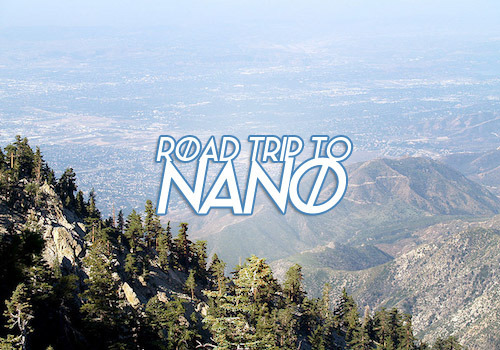
NaNoWriMo is a worldwide event, and we’re taking a Road Trip to NaNo to hear about the stories being written every year in our hundreds of participating regions. Today, Jennifer Carey, Municipal Liaison for the USA :: California :: Pomona Valley region, shares how founding her region in an unexpected place has motivated her as a writer:
The Pomona Valley Region came out of a need for representation. We are a community of twelve cities crossing the western region of the San Bernardino County and eastern region of the Los Angeles County. We are the blurred area where the urban life of LA meets a more spacious area that varies in terrain from suburbs, to old dairy farms in Chino, to a desert landscape in the east. There’s even some mountains tossed in for good measure.
I like to tell people that I live in the “suburbs of the suburbs” of Los Angeles. More importantly, I tell them that we Pomona Valley denizens are scrappers, survivors, and thrivers. We bounce to a beat of a different drum, coming from myriad backgrounds and stories. We are the Peacocks of Pomona!
I have made it my mission to create a more unified community among the creative people in the Pomona Valley region. In 2018—our eighth year as a region—we have nearly 600 writers, and nearly two hundred more who like to keep track of this region.
My best friends are people I’ve met at Write-Ins. At a particularly down time in my life—both of my parents died between 2010 and 2013, after long illnesses—it was my friends’ inspiration from their stories and approaches to life and writing which kept me eager to create more. I deal with depression and performance anxiety by challenging myself to reach new heights and create new opportunities.
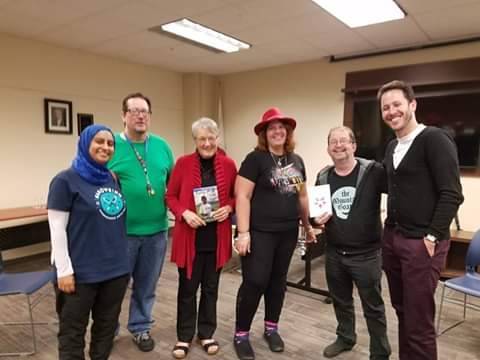 You can create more and achieve all of your dreams. Challenge yourself to be and do bigger and brighter things.
You can create more and achieve all of your dreams. Challenge yourself to be and do bigger and brighter things. Over the first week of NaNo, I am pushing myself to write whenever I have a free moment. By day two, I like having at least 15,000-20,000 words (I highly recommend checking out Milli Thornton’s page 10k Day for Writers.) You know that Hamilton quote? “Why do you write like you’re running out of time?” Well… you are. November 30th is the deadline and you can get there with 50k. What are you willing to be and do to make your book happen?
I love putting myself in varied spaces during NaNo. The invitation of different people and colorful spaces invigorates me. I set a few Write-Ins every week at different places. I also have spaces outside my region I venture to; it’s a treat I give myself during NaNo. I go out with fresh eyes and ears. I meet new people. I go and write where there’s life happening. Like our lives, our books are in the process of being created in the present moment.
NaNoWriMo is this hyper-real time where you are getting to experience things in a way that you don’t normally get to experience during the year. After fourteen years of doing NaNo, I have learned that I can take inspiration from anywhere, so I like to fill my head with new people and new spaces. There is a complete sense of freedom in writing the first draft with that set word count of 50,000.
It doesn’t matter how you get there, just as long as you get there.
Some people get their kicks on Route 66. I get them by taking part in NaNoWriMo.

Jennifer Redelle Carey is the creator and the current ML of the California :: Pomona Valley region. She is a creativity coach and copy editor. She received her BA in Creative Writing from UC Riverside in 2004. After fourteen years away from academia, she is itching to go back and will be applying to grad school next Spring. Jennifer’s dream is that everyone recognizes the creative gifts they have and allow themselves the space to express them.
Top photo licensed through Creative Commons by Mitch Barrie on Flickr, with added text.
October 29, 2018
NaNo 101: The Basics for First-Time Wrimos
 What is NaNoWriMo?
What is NaNoWriMo?
If you’re reading this, it means this is your first time doing something called NaNu—NaNa—what was it again? Your book-loving friend mentioned it last week, and it had something to do with November.
That’s it—National Novel Writing Month! It’s also known as NaNoWriMo (we’ll get the pronunciation down later).
National Novel Writing Month is a yearly event where you challenge yourself to write 50,000 words in 30 days. That comes out to about 1,667 words a day, which scientists have determined to be the perfect amount to boost your creativity. It all starts in the wee hours of November 1st (at 12:00:01 a.m., to be precise!) and continues until the final seconds of November 30th (at 11:59:59 p.m.).
Novelists from all around the world come together online (and often in person) to share their daily progress, take on writing dares, race each other in word sprints, and cheer each other on! By the time December 1st rolls around, you’ll have created something you may once have thought impossible: a draft of your very own novel (or, at least, part of one).
How do I do NaNoWriMo?Getting started is easier than… well, coming up with a suitable metaphor! All you need is a profile and an idea! The idea part isn’t even that necessary—many Wrimos write their novels without any outline or plan in mind (they’re called “pantsers,” and they’re everywhere).
Create your profile so your fellow Wrimos can connect and cheer you on!Create your novel as early as September (you can change it later). Give it a title and you’re good to go!
Choose a home region so you can learn about local events from your volunteer Municipal Liaison and writers in your area!
Earn badges by reaching milestones throughout the month!
Get inspired with pep talks, blog posts, and other resources to help you on your journey to writing superstardom.
Update your word count every day on the NaNoWriMo website and watch your novel climb to the finish line!
Claim your win by validating your novel starting on November 20th and through the end of the month. There’s no cash prize, but you get an awesome certificate (plus bragging rights, special sponsor goody rewards, and your very own novel !) What are some tips for winning NaNoWriMo?
If this all sounds pretty daunting, don’t worry — you’re not alone. Luckily, the NaNoWriMo community is full of writers happy to share their wisdom and tips for roaring through November in style. Here’s a few tidbits of advice from a recent Twitter thread:
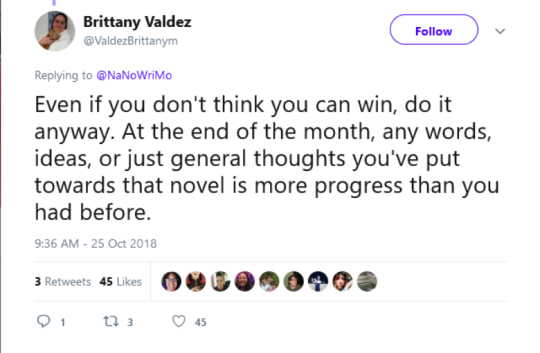



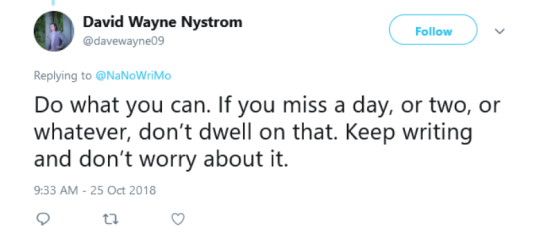
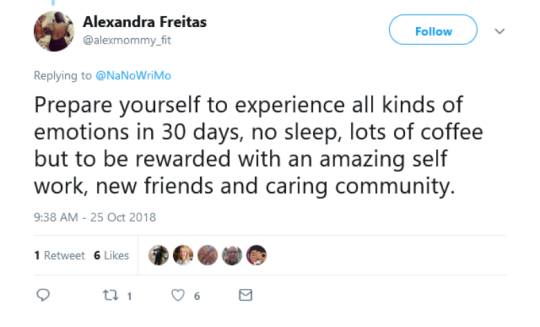
Now go—stock up on coffee, pencils, and comfy sweaters—and write that novel! We’ll be here to help you along the way throughout November and beyond.
October 26, 2018
The Mighty Pens: Join an Epic Writing Community
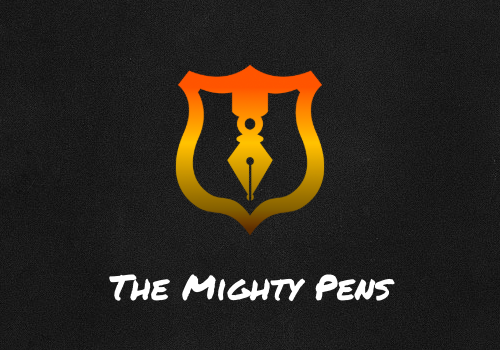
Ever wondered how you could directly support a nonprofit just by writing your novel? Today, author and NaNoWriMo Writers Board member Susan Dennard extends an invitation to join her writing group, to help support your novel as well as the members of the wider NaNoWriMo community:
Every year, NaNoWriMo takes the world by storm. And every year, since 2010, I have participated. Some years, I’ve won! Other years…yeah, not so much. But hey, I got words down, and that’s something.
Then there have been those handful of years where I didn’t write at all, yet I threw myself into the experience by hosting writing sprints or creating printable resources or running YouTube Q&As. Why? Because the sense of community during November is nothing short of epic.
What other time of the year can you walk into a coffee shop and know that at least half of the people there are typing away at a novel? It’s like a secret handshake, and we all share knowing glances across our coffee mugs. (Or maybe that’s just me and I’ve been coming across as a total creeper for 8 years.)
Of course, the incredible community that is NaNo can also be daunting. So many people! Writing! And sharing! And chatting online! For those of us who like things a bit smaller and a bit more contained, it can even be downright intimidating. In the past, I’ve always urged people to find their local NaNo chapters—and I still suggest this! But ever since finding my own tiny slice of community, I’ve been evangelizing it to everyone I know.
Meet The Mighty Pens. Formed by Kat Brauer and myself in 2017, the Mighty Pens are a combination of two things we love: charity and NaNoWriMo. Last year, we managed to raise $16,000 for the Malala Fund. This year, we’re hoping to do the same—but for NaNoWriMo.
“Because I knew I was raising money for a greater cause, I felt really held accountable.”So what are the Mighty Pens? It’s a group of writers who ask friends, family, colleagues, etc. to donate money whenever they hit specified word goals. Kind of like how runners will get each mile of a race sponsored, we’re just working with words instead! Last year, 89 people wrote with us (raising money along the way), and it was truly one of the most rewarding experiences of my life.
On top of that, because I knew I was raising money for a greater cause, I felt really held accountable. In the past, if I wasn’t winning NaNo, eh! Oh well. But once there was a goal on the line that was bigger than myself, then wow, did I want to get those words down.
And of course, now the Mighty Pens are some of my best writing friends. It was such a tight knit community last year, and I have no doubt we’ll create the same haven again. We have mentors to help the new members; we have daily sprint sessions planned; and we have a whole slew of epic prizes (ranging from signed books to agent critiques) for people who reach their fundraising goals.
So if you too love the community of NaNo, but you need something a bit more contained—or if you’re looking for greater accountability, or you simply want the chance to give back!—then I hope you’ll consider joining the Mighty Pens or spreading the word about our cause.

Susan Dennard has come a long way from small-town Georgia. Working in marine biology, she got to travel the world before she settled down as a full-time novelist and writing instructor. She is the author of the Something Strange and Deadly series as well as the New York Times bestselling Witchlands series, and she also manages the popular newsletter for writers, Misfits & Daydreamers. When not writing, she’s slaying darkspawn (on her Xbox) or earning bruises at the dojo. Learn more about her on her website and find hundreds of free writing resources on her blog.
October 25, 2018
7 Superb Self-Care Tips for Surviving November

While it’s tempting to spend November closed off from the world at your writing desk (or couch, or bed, or floor), it’s important to remember to take care of yourself. Self-care is essential to the success of you and your story, so today writer Erin Townsend shares her tips for keeping your health in check:
NaNoWriMo is an exciting, exhausting, and rewarding experience. It’s a time to forgo social events and hole up in your writing space, over-caffeinated and under-rested. If you’re one of many who struggles to maintain your mental health, this environment can be especially taxing. How do you implement self-care habits like exercising, sleeping, and eating well when you’re having a hard enough time fitting in writing itself?
1. Be socially antisocialIt’s easy to forget that your writing space doesn’t have to be a dark, secluded room in your apartment. If you like background noise, try a nearby cafe, or even a bar or brewery. If you’re easily distracted, join your local NaNo group for write-ins at your library, or write at the library on your own; there’s free wifi, lots of books to pull inspiration from, and less noise.
2. Write in NatureIf you don’t want to be around people (I hear you), try writing outside! Find a park or open patio or a bench under a tree. Hike a notebook to a nearby vista, and write at the top. Being surrounded by nature reduces stress levels, and scenery is inspiring. You might get some exercise at the same time!
From one night-owl to another: it’s tempting to stay up until dawn getting that daily word count in. Don’t get into the habit of doing this! If you’re feeling inspired, stop a scene in the middle so you’ll have inspiration left for tomorrow. Keep a notebook by your bed for writing down ideas to expand on later. Getting enough sleep is one of the most important things you can do for your mental health.
Too much caffeine can ramp up your anxiety levels and make you less productive. If you’re looking for something warm and comforting to ease you through writing, try tea. Ride-or-die coffee fanatic? Swap for decaf. You can make your favorite cup o’ joe a reward for hitting a certain word count, maybe half the daily amount, and use it to power through the rest.
5. Meal PlanWith all your spare time devoted to writing, it can be hard to maintain a healthy relationship with food during the NaNo season. Why spend hours in the kitchen when you can order Domino’s in five minutes? Combat the temptation with freezer-friendly soups, stews, and other meals, prepared ahead of time. Stock up on frozen fruits and veggies to have at the ready. Compile a list of cheap and easy recipes: sheet pan dinners, one-pot pastas, or minute-rice dishes. Don’t forget about the magic of the crock pot, if you have one. A little planning goes a long way.
6. Limit Social MediaStay off your phone. People will be taking selfies at bars, sharing snaps of concerts, and inviting you to events that you don’t have time for. If you need to wind down, read a few chapters of your favorite book. Not only is it less stressful, but it can inspire your writing. Work on a crossword. Listen to some music. You can catch up on the news later.
7. Know When to Take a BreakThe point of NaNoWriMo is to let the words flow, but if they’re not coming to you, don’t sit in front of a blank page and beat yourself up about it. Take a walk, cook something, spend a few minutes on a secondary hobby, or meet a friend for a drink. Sometimes stepping away from the writing and letting go of that stress is when inspiration strikes.

Erin Townsend writes from New Haven, Connecticut, where she co-organizes a writing and audience feedback series entitled Local Lit @ Lotta. Her work has received the Jennie Hackman Award for Short Fiction and has been published in the Long River Review. Currently she is working on her first short story collection. In her spare time, when she isn’t traveling around with her partner, Erin reads books about space and drinks weird beer.
Photo by Willian Justen de Vasconcellos on Unsplash.
October 24, 2018
How Dabble Can Help Make Writing Easy
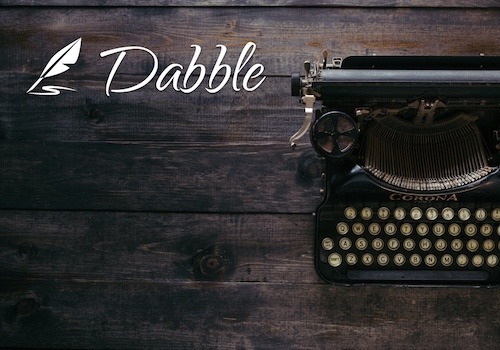
Every year, we’re lucky to have great sponsors for our nonprofit events. There are lots of options when it comes to writing software, but it’s important to find the one that works best for you. Today, author Sally Britton is here to tell you about Dabble, a NaNoWriMo 2018 sponsor:
In October 2017, I scrolled through the NaNoWriMo sponsor list, looking to see if any of the offers might appeal to me. There are always lovely sponsors, and I bought my first ever writing program with a NaNoWriMo winning discount code. Only one, with a whimsical quill pen logo, truly attracted my attention. A brand new subscription service. A way to write online, offline, track my word count, and promising to make writing “easy.” I scoffed. Out loud. I scrolled away, then came back. The logo was kinda cute. I clicked.
Here we are, a year later, and I’m writing a sponsor review. I’ve also self-published six titles, with modest success, and I freely attribute a portion of that success to Dabble.
NaNoWriMo friends, to say Dabble changed the way I write would be an understatement. I fought the lure of the program, even as I began to use it, because I had succumbed to writing software before that left me dizzy with settings, confounded by options, and frustrated by crashes. But Dabble was free for NaNoWriMo participants, so I used it, with every intention of finding fault. I wound up becoming a huge fan instead.
Let’s talk a little about the features of this writing program. You can create an unlimited number of manuscripts, all displayed with title and author name when you login. When you open your current project, the writing and plotting interface is clean, streamlined, and absolutely intuitive.
Dabble is a program of elegant simplicity with complete functionality. I can’t be the only one who spent more time getting the settings correct in other software programs than I actually spent writing in them. But with Dabble, I can open a new project and begin without making a dozen tweaks to settings hidden within menus.
If you’re a plotter, you can begin by clicking the “Plot” menu. Then you can create your first plot line, and then several more if you are weaving together a story with any intricacy.
As a historical romance writer, this is an incredibly useful feature. I can view his plot line, hers, theirs as a couple, my antagonist’s, and my subplots all in the “Plot Grid” screen. This helps me keep everything organized and hitting the right points at the same time, and it’s easy to drag, drop, and insert new little index cards wherever necessary.
But what if you like to fly by the seat of your pants? Dabble makes that easy too. On the left side of your screen, there’s a beautiful menu where you can see the contents of your book. You can add individual scenes, chapters, or view the whole thing like in an old-school Word doc. You can drag scenes around, too, and keep notes on what needs to happen or what your goals are—it’s really beautiful, how Dabble caters to both the super organized and those of us with less of a plan.
If I had enough words and a dozen screenshots, I’d give you a whole tour. But let’s hit the high points for NaNoWriMo users this November:
Any free trial started on Dabble from October 1st will automatically extend to December 1st. That’s ample time for you to try this thing out.You can set word count goals directly in Dabble, as well as select “Days Off” from writing so your numbers will accurately reflect how much you have to write without you having to do a ton of math. (I’m a writer. Not a mathematician.)Word counts in Dabble will sync up to your NaNoWriMo profile! I loved that feature last year.There are discounts on the subscription just for us!Dabble is a subscription-based program. Don’t let that scare you. It is, in fact, brilliant. A constant stream of revenue for any service means constant updates. Besides, there are some pretty great discounts for those of us in NaNoWriMo land.
Want to know my favorite part about Dabble? It’s the creator, Jacob Wright. When I first started using Dabble it was only two months old. Brand new. I encountered a glitch (that I’ve since never had trouble with again) and lost thousands of words. It was at 11:15 PM MDT. I tried not to panic. I sent a help request and went to bed. Fifteen minutes later, I had an email from the developer letting me know my words were all back. I checked, and he was right. Wow.
I’ve had other minor questions and insignificant issues a time or two after that (nothing for months and months now), and every time the response from the developer was rapid, polite, and helpful. His blog posts, especially the Road Map of future developments for the program, are engaging and personable. I believe in supporting people, and Jacob Wright is someone I believe in. He’s building something incredible, and he’s doing it for us. For writers.
I won NaNoWriMo 2017 because of Dabble. I’ve no doubt of that. I’ve written five novels using Dabble, and I’ve never looked back. Dabble is going to help me win this year, and publish three more titles before Spring 2019. It’s my secret to success and the happily ever after to my writing story. Why not see if it’s the perfect match for you, too?
Sally Britton is a full time author who lives in the middle of a desert with her husband, four kids, and a dog named Cherry. She started writing on her mom’s electric typewriter when she was fourteen and hasn’t stopped since. Sally writes historical romance and two of her six published novels were NaNoWriMo wins.
Top photo by Patrick Fore on Unsplash, with added text.
October 23, 2018
Road Trip to NaNo: Building a Tight-Knit Writing Community

NaNoWriMo is an international event, and we’re taking a Road Trip to NaNo to hear about the stories being written every year in our hundreds of participating regions. Today, Helena Verdier, Municipal Liaison for the Canada :: Ontario :: Ottawa region, shares how her region has shaped her writing:
Since the first write-in I attended over 6 years ago, Ottawa has proven to be a special place. We may not have the best food or the most beautiful sights, but we have this amazing community that comes together through everything and anything. We were recently hit by a tornado that left most of the west end of the city without power for days and destroyed countless homes and businesses within the city and a small town just outside. But just like always, the community came together to support one another.
The most special feeling about Ottawa is the big city with the small-town feel. That feeling of community with all the big city attractions? We’ve got it. And every November I’m still astounded by the variety of people who show up to write their novels together and become this amazing community. Need a name for this new character who just walked onto the page? Someone has a great name to share. Not sure how a specific business is run? Guaranteed someone knows all the ins and outs of it.
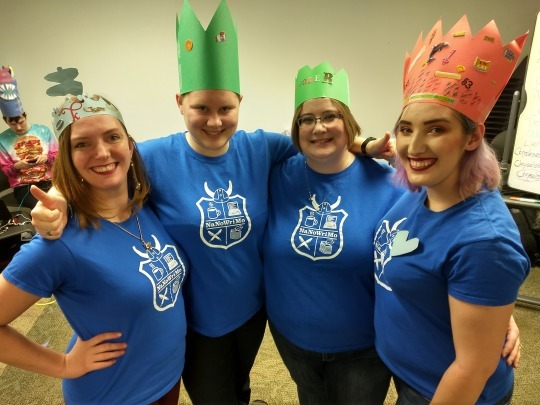
Whatever your question is, I’m sure someone either knows the answer or knows where to find an answer for you. The amount of times I’ve asked a question to the people around me and had the perfect answer given to me is massive. Almost equal to that is the amount of times I’ve started to ask a question only to figure out the answer halfway through. It always makes people chuckle.
NaNowriMo has a way of bringing people together, and the Ottawa group continues to surprise me with every new Wrimo that shows up. From our former Municipal Liaison (ML) who writes at the speed of light, my NaNo-Wife who continues to push me to write more every year, to our hilarious storyteller who’s a proud new dog-dad, everyone brings something unique to the table. Weaving that uniqueness into my stories over the years has been wonderful and is not something that I would trade for anything.
Every write-in proves that our little NaNo community is amazing in every way. They continue to show up when the first snow storm hits, their big smiles hidden behind warms layers. They also show up when we decide to build a blanket fort and write till the sun comes up. I like to think that the support we all bring to each other has no match, anywhere else in the world.
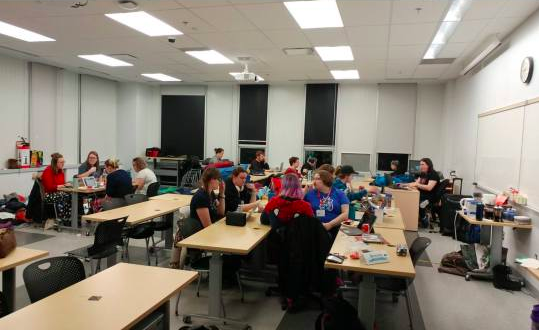
That being said, every local region is special, and the best parts are the people that make it up. Everyone comes with such unique experiences and personalities, and that wealth of knowledge is a hidden gem for your stories. Take full advantage of what’s in front of you, your novel will thank you. So, I challenge you to get to know the writers around you and build up your own writing community. Find someone who writes at the same pace and challenge each other. Enjoy writing in a supportive community who all want to write the best story they can. Who knows, you just may end up being the reason someone comes back every year.

Helena Verdier is a twenty-something student and government worker. When not adding more things to her long list of university accolades, she is busy thinking about what to write next and helping her co-MLs plan next years NaNoWriMo events for her region. She also spends copious amounts of time annoying her cats with affection while simultaneously trying to figure how she’ll teach them to swim once they all finally move to the east coast of Canada.
Top photo licensed under Creative Commons from David McCormack on Flickr, with added text.
October 22, 2018
Escape the News Cycle and Focus (With Help from Your Guilty Pleasure Movie Characters)

As November approaches, you might be struggling to find both the time and the mental energy to write. One of the most distracting (and often disheartening) impediments to your writing can be the endless news cycle. Today, author, editor, and writing coach Kendra Levin shares some tips from your favorite guilty pleasure movies on how to focus on your writing next month:
The news cycle has become the addictive reality show we love to hate (or maybe just hate to hate), and it’s easy to feel like skipping even one day of it means missing crucial information. The idea of unplugging from it entirely for a whole month might seem a bit unrealistic. On the other hand, to do NaNoWriMo this year, you’ll have to find some way to partly disconnect from the endless stream of media. But in a world that is increasingly full of extremes, is it even possible to “partly disconnect” anymore? Four favorite fictional characters show us how to set boundaries for November so you can strike a healthy balance between news junkie and hermit in the woods.
1. Make a declaration of your priorities for November.
Inspiration: Bridget Jones from Bridget Jones’ Diary
As powerless as we often feel in the face of the news, one aspect of our lives we do have agency over is how we spend our time and how we expend our energy. Before NaNoWriMo begins, take a little time to set your intentions. Think about the month ahead and consciously rank your priorities: what’s essential, what’s important, what’s optional—and bucket everything else as, at least for this one month, “unimportant.” You may want to post this ranking somewhere close to hand as a continual reminder.
2. Limit your daily (or weekly) allotment of news consumption—and be specific.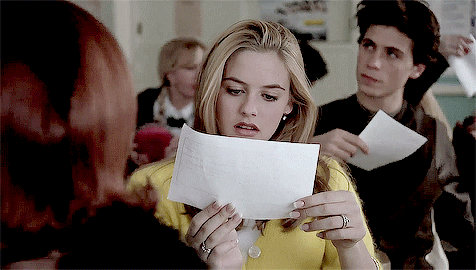
Inspiration: Cher from Clueless
Instead of giving yourself free rein to read, watch, or listen to the news, ask yourself the following questions: How many minutes per day do I want to consume news media during NaNoWriMo? What will help me be most focused on my writing: to consume news before, during, or after my writing hours for the day? What media sources do I want to limit myself to during the month of November? Use your answers to these questions to set boundaries you’ll stick to.
3. Turn the dial on your social media WAY down…or turn it off entirely.Inspiration: Andrea Sachs from The Devil Wears Prada
It’s a platform for self-expression, a way to communicate with friends and strangers, and a legitimate source of behavioral addiction. It’s also a giant time-suck and a constant reminder of the most dramatic and most anxiety-making aspects of the day’s headlines. Need I say more? For the next month, back away from the feeds. Your novel (and your psyche) will thank you.
4. Don’t get burnt out, get fueled!Inspiration: Bernadine Harris from Waiting to Exhale
Let’s say you do take a peek at today’s headlines… and your immediate response is any combination of the following: shock, horror, rage, dread, terror, grief, resignation, or something similar. Instead of being dragged underwater by these anguished emotions, how can you use them as fuel for your writing? How can you infuse your characters with what you’re feeling to make these fictional people more real and to fill your manuscript with the crackle of genuine emotion? Turning your reaction to the news into fuel for your art is one of the healthiest ways to process it, for your body and psyche. And it’ll increase your word count.
Finally, when the struggle to find a workable balance between writing a novel and absorbing the ceaseless blows of the latest news feels like too much for you, don’t forget to give your brain an occasional respite. My top suggestion: re-watching a favorite movie.

Kendra Levin helps writers and other creative artists meet their goals and connect more deeply with their work and themselves. She is an editorial director at Penguin, a certified life coach, and author of
The Hero Is You
. Visit her at
kendracoaching.com
and follow her
@kendralevin
. To win a coaching session with Kendra by supporting NaNoWriMo, check out the
Night of Writing Dangerously
!
Top photo by Elijah O'Donnell on Unsplash.
October 19, 2018
The Inspiring Reasons Why People Write
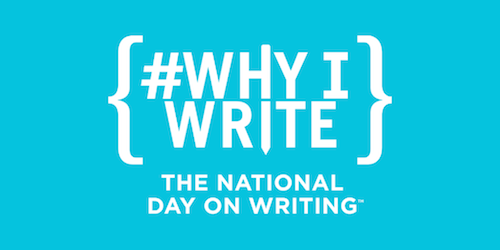 Why do you write?
Why do you write?Tomorrow is the National Day on Writing, an annual event founded by the National Council of Teachers of English because, in their words, “writing needs greater attention and celebration.” We couldn’t agree more, so to celebrate, we want to know why you write! Share what fuels your creative fire with #WhyIWrite. Here are a few of our favorite answers so far:
From Instagram user alexandrasendas:
I write because I like being creative and seeing my imagination come to life
Chris Baty's Blog
- Chris Baty's profile
- 63 followers



